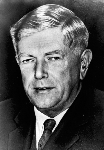
Sir Burnet successfully applied the ideas of population dynamics, first propounded by Darwin approximately a century earlier, to immunology. The body's immune system has the capacity to react to a dizzying variety of foreign substances (antigens) by creating specialized substances (antibodies) that can immobilize and destroy the invaders. Antibodies are produced by B-cells, which circulate in the bloodstream responding to antigens. In order to be able to respond to any potential antigen, the B-cells must have the capacity to create a wide range of antibodies. Since encoding each possible antibody in the genetic code would consume much of our DNA, B-cells use a complex system of genetic recombination to ensure maximum variability.
Burnet's major observation was that this system feeds back on itself in order to select antibodies that best bind to a given antigen. Take a stylized example: if a square antigen enters the bloodstream, B-cells will immediately start producing producing antibodies to bind to it. Some of these antibodies, however, will not bind to the antigen at all. Some will bind the antigen loosely, and some will bind it tightly. Those that best fit the square will be replicated, and the others will not. Through a process of "survival of the fittest," the most effective antigens will be produced.
This was a step beyond Pauling's theory that a single antibody adapted itself to each antigen. Although Burnet did not have the tools to outline the mechanisms of clonal selection, later experiments were able to develop a highly detailed genetic explanation. All antibodies have both constant and variable regions. These variable regions are encoded in a number of adjacent DNA segments that can recombine with constant sections of code.
Inside Links
Outside Links